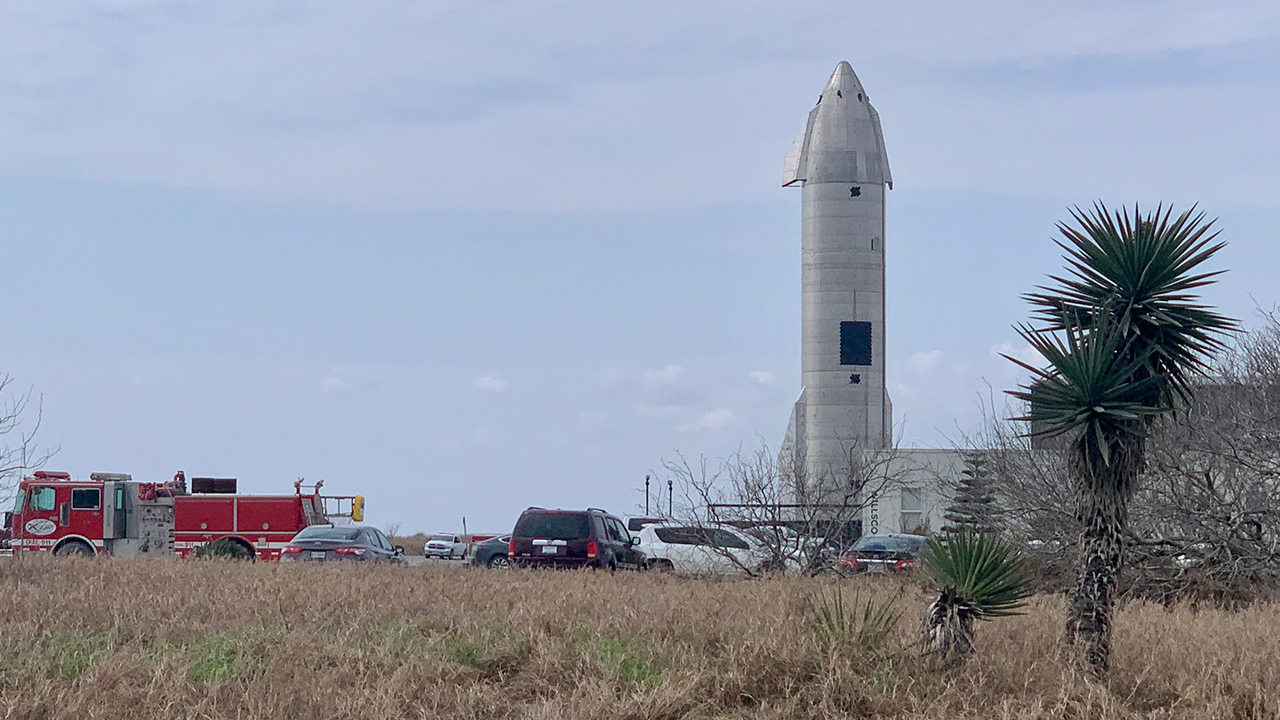SpaceX test fires Starship SN11 rocket prototype again ahead of next launch
There was no Starship launch in Texas today.
SpaceX test fired its latest Starship rocket prototype Friday morning (March 26) but did not attempt a launch from its fog-shrouded pad at the company's Starbase facility in South Texas.
The Starship SN11 vehicle fired up its Raptor engines just after 9 a.m. EDT (1300 GMT) ahead of what was expected to be a 6.2-mile (10 kilometers) launch later in the day.
"Standing down SN11 until probably Monday," SpaceX CEO Elon Musk wrote on Twitter Friday. "Additional checkouts are needed. Doing our best to land & fully recover."
Video: Watch SpaceX test-fire the Starship SN11 rocket prototype

SpaceX's Starship website announced the SN11 launch was possible on Friday, but did not give a specific time for the attempt.
On Thursday, officials in Cameron County, which is home to SpaceX's Starship test site near Boca Chica Village, announced road closures for most of Friday to accommodate SpaceX's test flight.
"I have ordered the closer of Boca Chica Beach and Hwy 4 for the purpose of protecting Public Health and Safety during SpaceX engine testing and 10 km flight, in the time period between 7:00 a.m. C.S.T. to 7:30 p.m. C.S.T., of the same day," Cameron County Judge Eddie Trevino, Jr., said in a statement. "If members of the public would like to view the flight, please do so from a safe distance and away from Boca Chica Beach."
Get the Space.com Newsletter
Breaking space news, the latest updates on rocket launches, skywatching events and more!
By 4 p.m. EDT (2000 GMT), those road closures were lifted and it was clear no launch would occur. Foggy conditions persisted as SpaceX's Starbase facility throughout the day, but it was unclear if the weather was why the company stood down from a launch try.
"Testing Concluded. Hwy 4 and Boca Chica Beach are now open," Cameron County officials wrote in an update.
Join the Space.com forums here to discuss SpaceX and space travel. Let the community know what you're thinking!
SpaceX's Starship SN11 rocket is the latest prototype for a fully reusable spacecraft capable of missions to the moon and beyond. The company is developing the 165-foot-tall (50 meters) rocket and a massive booster called Super Heavy to fly astronauts and other gear to the moon and Mars. SpaceX CEO Elon Musk unveiled the first Super Heavy prototype, a test version that will not fly, last week.
As its name suggests, the SN11 rocket is SpaceX's 11th Starship prototype. The private spaceflight company has launched three other prototypes so far— SN8, SN9 and SN10 — from its facility near Boca Chia Beach, though none of them ultimately survived.
The Starship SN10 prototype was the first to actually land, but exploded a few minutes after touchdown. SpaceX has been tweaking Starship's design with each launch to improve its performance.
On Monday (March 26), SpaceX test-fired its Starship SN11 rocket, setting the stage for an upcoming test flight. Like its recent predecessors, SN11 is powered by three of SpaceX's Raptor engines.
"Similar to previous high-altitude flight tests of Starship, SN11 will be powered through ascent by three Raptor engines, each shutting down in sequence prior to the vehicle reaching apogee – approximately 10 km in altitude," SpaceX wrote in an update. "SN11 will perform a propellant transition to the internal header tanks, which hold landing propellant, before reorienting itself for reentry and a controlled aerodynamic descent."
SpaceX has already lined up customers for its Starship vehicle even as the company continues to refine the design of the spacecraft and its Super Heavy booster.
Japanese billionaire Yusaku Maezawa has signed up for a trip around the moon aboard a Starship for himself and eight other people. That mission, called "dearMoon," is targeted to launch in 2023. NASA has also selected Starship as one of three contenders to land astronauts and payloads on the moon as part of the space agency's Artemis program.
Email Tariq Malik at tmalik@space.com or follow him @tariqjmalik. Follow us @Spacedotcom, Facebook and Instagram.
Join our Space Forums to keep talking space on the latest missions, night sky and more! And if you have a news tip, correction or comment, let us know at: community@space.com.

Tariq is the Editor-in-Chief of Space.com and joined the team in 2001, first as an intern and staff writer, and later as an editor. He covers human spaceflight, exploration and space science, as well as skywatching and entertainment. He became Space.com's Managing Editor in 2009 and Editor-in-Chief in 2019. Before joining Space.com, Tariq was a staff reporter for The Los Angeles Times covering education and city beats in La Habra, Fullerton and Huntington Beach. In October 2022, Tariq received the Harry Kolcum Award for excellence in space reporting from the National Space Club Florida Committee. He is also an Eagle Scout (yes, he has the Space Exploration merit badge) and went to Space Camp four times as a kid and a fifth time as an adult. He has journalism degrees from the University of Southern California and New York University. You can find Tariq at Space.com and as the co-host to the This Week In Space podcast with space historian Rod Pyle on the TWiT network. To see his latest project, you can follow Tariq on Twitter @tariqjmalik.









